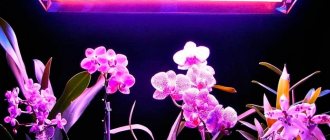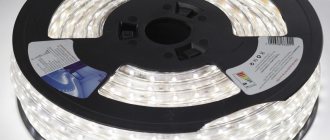LED lamps are superior to incandescent lamps in many respects: they are more economical, do not affect the room temperature, last longer and are more environmentally friendly. To choose LED lamps that will properly illuminate your house or apartment, you should approach the search process wisely. How to choose LED lamps. Which manufacturers' products can you trust?
To purchase a high-quality LED lamp for your home, you need to pay attention not only to the technical characteristics of the product, but also to the brand, cost and packaging of the product.
Operating principle and design of an LED lamp
Different types of LED lamps
For the operation of the devices, a more complex circuit is used than in standard Ilyich lamps. After applying an electrical impulse, the chemical elements of two dissimilar substances are activated, and at the moment of their contact a glow appears.
The main nuance of the interaction scheme is that the materials used are not full conductors of electricity, but only semiconductors. Current is passed in the desired direction only if the active elements of each substance are connected. In addition to producing light, the interaction of substances contributes to other processes, for example, the release of heat.
LED lamp design
The appearance of LED light bulbs resembles classic incandescent lamps. But the components are somewhat different. A standard LED lamp is assembled from the following elements:
- diffuser;
- Light-emitting diode;
- radiator;
- driver;
- contact base.
Conventional LED devices cannot work with household voltage of 220 V - the lamps burn out instantly. To correct the situation, additionally install power and control units (microcircuits), which allow you to reduce the voltage and straighten the direction of the incoming current.
Advantages of LED lamps
LED lamps have a number of undeniable advantages, thanks to which users replace the usual incandescent light bulbs with them. These include:
- high brightness of lighting;
- low power consumption;
- low sensitivity to changes and frequent switching on/off.
The best LED light bulbs for the home have each of these advantages in full. But every year manufacturers release new device models with additional functions and innovative solutions.
Transmitted colors
When choosing, it is also recommended to take into account the so-called color rendering coefficient. It is recommended to choose devices with a coefficient above 80. A coefficient of 95 is considered optimal, but the cost of such lamps can be 2-3 times higher than conventional ones. The number indicating the coefficient is indicated on the back of the package.
Attention:
The higher the color rendering coefficient, the more expensive the product. If the box says 90-95, but the lamp itself is in the lower price category, then the manufacturer is manipulating the numbers.
Types of LED lamps
To choose an LED lamp, you need to familiarize yourself with the main classification and key differences between each type.
Standard
Standard LED lamp
Classic models with electricity consumption of 30-40 W, but the average value is about 5-12 W. The devices work for a long time; under certain conditions they can last more than three years. A distinctive feature is that during operation they practically do not emit heat, therefore they do not pose a danger to fusible materials around.
There are no harmful vapors (for example, mercury) inside the glass bulbs of such light bulbs. There is also no fragile filament, so the mechanism will not fail due to shaking. An additional advantage is the variety of shapes, sizes and styles of lamps.
RGB lamps
RGB lamp
The abbreviation is formed from the first letters of the three names of colors in English - red, green and blue. Light bulbs with this mark can shine in any shade, which is made up of three main ones (red, green and blue). RGB light bulbs have no other differences. For domestic premises they are used only for decoration - they cannot shine with ordinary light.
Rechargeable
The main difference between the lamps is the presence of a battery. These devices come in two types:
- work from the network, switch to a spare unit in the event of a power outage;
- completely autonomous, they light only from the power supply.
Rechargeable lamps respond well to aggressive climatic conditions, such as sudden temperature changes. They work for an average of three to five years.
LED lamps with remote control
LED RGB lamp with remote control 220V E27
They are considered the most comfortable to use. The remote control operates via infrared or radio signal. An additional control device helps solve several issues - adjust the brightness of the light, turn on/off the circuit remotely, activate some programs (rhythmic or colored flickering).
The main disadvantages include the high cost of light bulbs, installation difficulties and the appearance of another remote control in the room. Otherwise, the lamps are economical, shine brightly, and work for a long time. In addition to the remote control, they use Wi-Fi - special models for smart home technology.
Is a radiator needed?
During operation, the LED generates quite a lot of heat, which must be effectively removed and dissipated. To do this, small metal radiators with a wavy or ribbed surface are installed in the lamps. LEDs without heatsinks quickly fail, so purchasing them is not recommended. Remember that the cost of LED light bulbs is quite high, so you don’t need to save “on matches” by buying a model that is 15 rubles cheaper because it does not have a cooling system.
Note:
if the lamp has a plastic reflector, it will not be effective (dissipates no more than 15% of the generated heat). It is better not to choose such models so that they do not burn out during prolonged use.
Most often, aluminum radiators are used for cooling - they are inexpensive and effectively dissipate heat. Look at the lamp - you will see it near the diodes. If the bulb of the lamp is matte and the radiator is not visible, then be sure to ask the seller about its availability or choose another model. Additionally, it is recommended to study reviews about the manufacturer so that you are not surprised by discrepancies in glow temperature and other parameters.
Options for choosing an LED lamp for your home
To choose an LED lamp, you need to know the basic characteristics of the devices and the electrical network. Only correctly selected products will work for a long time and really save energy.
Power and luminous flux
The power of an LED lamp shows how much electrical energy the light bulb consumes. Most consumers, when replacing Ilyich devices, primarily focus on this indicator.
When purchasing, you must be guided by specially developed relationships and tables. The values of power and other characteristics may differ significantly with the same external indicators.
For example, a 100W incandescent bulb corresponds to a 12W LED bulb. Therefore, before purchasing, it is better to check the indicators several times.
Luminous flux level indicates how bright the light emitted from the bulb will be. Even the best manufacturers rarely indicate this on the packaging.
Colorful temperature
The value is expressed in Kelvin and shows the shade of the light bulb. LED devices can be purchased with a warm or cool type of light. The higher the digital designation, the closer the indicator is to the daily level. Below, the light is warm, closer to the candle flame. Natural white light is indicated at 4200K (plus/minus).
Base type
Purpose of lamp bases
A base is a part that allows you to connect a light bulb with an electrical circuit and fix it in the socket. There are a large number of sizes and diameters, but several are suitable for household use:
- E14 – “candle”, “minion”;
- E27 is a standard light bulb, most products are manufactured in this version;
- E40 – enlarged base for street lighting fixtures.
Lamps marked with the letter G are analog and are suitable for replacing halogen, tubular and other types of light bulbs.
Scattering angle
The indicator will help you navigate the area illuminated by the light bulb. The higher the value, the greater the seizure of territory. 30° lamps work like a large flashlight, rarely suitable for home use (unless in a narrow hallway or bathroom). 90° bulbs are used in large rooms and outdoors.
Presence of a radiator
LED lamp radiator
The radiator is an aluminum cuff between the base and bulb of the LED lamp. It is responsible for removing excess heat, thereby extending the life of lighting equipment. The absence of this element or its replacement with a decorative plastic attachment is the first sign that this is a fake or simply a poorly designed light bulb that will not last 3-5 years.
Dimmable
Dimmers are small devices that allow you to control the brightness of a lamp. The design of a classic LED lamp does not include additional regulators and cannot work with them - low voltage with minimal lighting will not start the flow of electric current to the LEDs (obstacle - built-in drivers).
The solution was the creation of special dimming LED light bulbs, the operation of which is ensured by a modified driver (a board inside the device). The packaging should indicate that this lamp can work with dimmers.
Dimming occurs by controlling the frequency of the light, which inevitably causes flickering and pulsation on the lamp. You can eliminate the appearance only by completely abandoning the use of dimmers.
Manufacturers rating
We will start with unscrupulous suppliers, since choosing an LED lamp according to technical parameters is half the battle. The next step is to choose a manufacturer. As you know, LED lamps are far from cheap, and the temptation to find a cheaper product is not the least important for the thrifty buyer. Unfortunately, cheap cheese, as they say in a mousetrap, and unscrupulous Chinese suppliers were not long in coming.
Externally, the lamps look attractive, but the internal contents will show negative aspects in the near future. Most likely, they will burn out without serving for a year, and the lack of a warranty will save the seller from compensating your costs - it is better not to buy such LED lamps for your home. Look carefully at the packaging - poor printing and lack of a warranty period will serve as a warning sign for you to refuse to purchase a low-quality product.
Is it worth mentioning that such products are assembled from the cheapest components. The color rendering coefficient barely reaches 60 Ra, the diode driver does not cope with the task as a result, the LED lamp flickers when turned on and blinks when turned off.
The service life of such a lamp is pure luck. In a word, saving on the purchase will come out “sideways”. We won’t reveal any secrets by saying that you can save money if you initially choose a product from trusted brands and follow a simple rule - it’s better to purchase LED lamps for your home from reliable suppliers.
High quality LED lamps
Companies registered in the European Union can boast of excellent performance. The companies Philips and Osram, which have earned people's trust, offer expensive, but high-quality and certified products. The company's head offices are located in the European part of the globe, while production facilities are located in Asia and China. Don’t be surprised by the inscription “made in China”; the industrial products of this country are under strict control and you don’t have to worry about the technical characteristics.
The products are not cheap; LED lamps from Philips sell from 700 to 1900 rubles apiece. The Osram company produces both budget models in the price category from 100 to 250 rubles, and a premium segment with a price of 2,600 rubles.
Acceptable quality and low price of LED lamps
We will find the optimal ratio of cost and quality from middle-class suppliers. The price category required by a wide range includes Russian, Asian, Chinese and many other manufacturers. Products are offered with good and realistic performance and are presented in a wide range. For example:
- Domestic manufacturer Feron (Feron). Successfully mastered the production of lighting equipment using LEDs. Prices start from just 70 rubles for low-power lamps. More powerful ones will cost 400 rubles.
- A wide range of LED lamps is offered by the Hong Kong company Camelion. Large range with bases for all sizes. Price from 100 rubles to 500.
- The glorious city on the Neva supplies products under the Jazzway brand. LED lamps differ from the manufacturer in their base. Both flask and “corn” are manufactured. Average prices on the shelves range from 100 to 400 rubles for a standard power not exceeding 20 W. A special offer for powerful options up to 60 W reaches 6,700 rubles per unit.
- Another domestic manufacturer boasts Russian roots. Gauss deservedly occupies a leading position. The cost ranges from 100 rubles for a model of LED lamps with average characteristics. With the efficiency of the lamp, the price also increases to 1,700 rubles for an offer with ultra-economical indicators.
Video review of LED lamps
- A well-known and respected Russian supplier is Navigator. A characteristic feature is a proprietary driver that provides stable operating parameters despite voltage surges (operability from 170 V to 250 V). The cost is in the average range from 100 and reaches 900 rubles for light bulbs with good efficiency.
- A completely new company - Era. The domestic brand is considered a newcomer to the market, but has already earned positive reviews and provides competitive prices - with a maximum cost of 500 rubles. A quality product with stable parameters.
- Chinese industrialist with the Selecta brand is included in our rating of acceptable manufacturers with good reviews. The range of product costs is from 100 to 1000 rubles.
- Our impromptu rating is completed by the Estares brand. A supplier from the Middle Kingdom offers LED lamps at prices up to 500 rubles. Premium line - from 1100 to 1800 rubles.
Results
The market is filled with a huge number of companies and firms that produce and supply LED lamps. Many companies are introducing LED lamps into their finished products - an example is the world-famous company Armstrong
, offering ceilings with built-in diodes.
Others are in high demand for products and supply low-quality goods. We hope that our article answered your question about how to choose an LED lamp for your home and fit into the family budget - we once again advise that it is better not to skimp on the brand. Enjoy the shopping.
What parameters need to be taken into account
Color rendering index
To choose an LED lamp for your home, you need to take into account several parameters that ensure comfortable lighting in your living space:
- Color spectrum - lamps with a yellow tint of emitted flux are suitable for residential premises, the color temperature for recreation areas should be 2700-2800K, for a desktop - with warm white light and a temperature of 3000K; voltage range – 110-230 V.
- To preserve the natural colors of all objects in the room, choose LED lamps with a color rendering index of 80 CRA.
- Depending on where the lamp is placed, a directed flow of light or diffused light may be required. These effects depend on the scattering angle, which can range from 30 to 360°.
- Only lamps with a pulsation range of 5-15% will have imperceptible flickering.
Lighting standards for various rooms
Also, when choosing lamps for residential premises, it is convenient to use the SNiP recommendations regarding illumination standards (lm/sq.m):
- bedroom, kitchen – 150;
- children's room – 200;
- toilet, bathroom – 50;
- office – 300-500.
It is also important to consider the manufacturer. The most reliable brands are those from Europe and Japan. The cost is higher than Chinese ones, but the likelihood of counterfeiting and purchasing a low-quality product is much lower. Philips, Nichia, Osram are considered the best on the market.
Color spectrum
This characteristic refers to how warm the lighting tone will be. Otherwise, this criterion is usually called color temperature, which is measured in degrees Kelvin (K). The higher the number, the colder the color spectrum:
- 2700-2800 - warm yellow
- 3000 - warm white
- 3500 - regular white
- 6500 - cool white
It is believed that natural white light is conducive to work - it increases efficiency. But warm yellow, on the contrary, helps to relax and tunes the brain to rest. Too cold a shade causes tension, so it is not recommended for use in rooms where people spend a long time.
| Colorful temperature | Hue | Characteristics and scope |
| 2700 K | Warm white with a reddish tint | This light is emitted by incandescent lamps of not very high power. Feeling of warmth and comfort. |
| 3000 K | Warm white with a yellowish tint | Characteristic of halogen lamps, the light is slightly cooler. |
| 3500 K | Regular white or neutral white | Characteristic of fluorescent lamps. Neutral light that does not distort color perception. |
| 4000 K | Cold white | Used in some modern styles - high-tech, for example. It can tire you with its “sterility”. |
| 5000-6000 K | Daylight | Used for lighting greenhouses. Too bright for home lighting. |
| 6500 K | Cold daytime, has a bluish tint | Very bright. Used for photo and video shooting. |
How to choose the right one based on prices and manufacturers
When choosing a new lamp, you need to pay attention to the manufacturer and the cost of the product
Expensive or cheap
Some people try to save money and buy cheap models because of this. However, it is better to overpay a little and buy more expensive lamps, as they are much better quality.
To select and purchase a high-quality lamp, you need to familiarize yourself with well-known manufacturers.
Philips
This company is a leader in the production of lamps. Philips products are known for their durability and reliability.
Osram
People who want to purchase quality lamps should pay attention to Osram. Products from this German brand are practically in no way inferior to light bulbs made by Philips
Volta
This is another German manufacturer specializing in the creation of LED light bulbs. The advantages of Wolta products include uniform light distribution.
Nichia
A Japanese company engaged in the production and sale of LED light bulbs. The company is also known for its high-quality batteries.
X-Flash
Fans of economical light bulbs can pay attention to products from X-Flash. The company produces economical twelve-volt lamps for lighting residential premises.
Lisma
"Lisma" is considered a popular company for the production of LED lamps among all CIS countries. The products produced by this company are distinguished by a wide angle of illumination.
Navigator
The company produces energy-saving light bulbs of various shapes and types. Navigator also produces decorative products used for interior decoration.
Gauss
This manufacturer is known for its high-quality lighting technology. Products that were manufactured by Gauss have a service life of seven years.
Camelion
It produces high-quality products. The range of manufactured products includes lamps for the home and products for outdoor lighting.
Feron
Manufactures a wide range of products. They are engaged in the production of light bulbs that glow in red, green, daylight and white light.
Jazzway
The company is engaged in the creation of high-power lighting devices that are suitable for large rooms or outdoors.
Era
"Era" is a young company that has recently started creating electric lamps. The variety of products allows a person to choose the right product.
Selecta
Another young company that appeared a few years ago. Selecta produces electric lamps, spotlights, electric sockets and even sockets.
A.S.D.
People who are on a budget can purchase lamps from ASD. They are considered the best in the budget segment.
"Space"
This is a Russian company that has been producing LED lamps for 25 years. "Cosmos" produces high-quality lamps that are suitable for the home.
GOST Lamp power.
In 2004, the GOST 8607-82 standard was adopted. "Lamps for lighting residential and public premises."
Its meaning is to limit the power of each type of lamp to a certain value. Those. Our manufacturers cannot produce night lights that consume more than 25 W. As is the limit on each lamp of this lamp. Everything is tied to the standard type of electrical network in apartments and houses. Moreover, our rules, as it turns out, are even less strict than abroad. Thanks to this, lamps from foreign manufacturers are quite suitable for our electrical network.
So, the lamp power limitation is:
— 550 W — for general lighting fixtures (the power of one lamp is not more than 150 W);
— 180 W — for combined lighting fixtures (the power of one lamp is not more than 150 W);
— 150 W — for exposure (spot) lamps (power of one lamp no more than 100 W) and decorative lighting (power of one lamp no more than 60 W);
— 25 W — for night lights (orienting lighting) (the power of one lamp is no more than 25 W).











